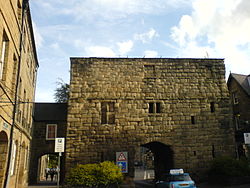| Bondgate Tower | |
|---|---|
 | |
| Coordinates | 55°24′45″N01°42′13″W / 55.41250°N 1.70361°W |
| Built | 1450 |
| Architect | Henry Percy, 2nd Earl of Northumberland |
Listed Building – Grade I | |
| Official name | The Hotspur Gateway or Bondgate Tower |
| Designated | 20 February 1952 [1] |
| Reference no. | 1041513 |
| Official name | Bondgate Tower [2] |
| Reference no. | 1006597 |

Bondgate Tower also known as the Hotspur Tower or the Hotspur Gateway in reference to Sir Henry Percy (commonly known as Harry Hotspur), son of the 1st Earl of Northumberland and father of the 2nd Earl of Northumberland. Although commonly called a tower it is actually a gatehouse. It has three storeys constructed of stone and consists of a recessed archway flanked by two polygonal towers. It is located in Alnwick, Northumberland in the United Kingdom. The gatehouse straddles Bondgate (the B6346), the main road of Alnwick. Low traffic can pass though its entrance while tall vehicles must take diversions to get past. A licence was granted in 1434 by Henry V to Henry Percy 2nd Earl of Northumberland to wall the town and add battlements. [3] These took fifty years to complete, with Bondgate Tower being finished around 1450. [4] [5] [6] [7]


